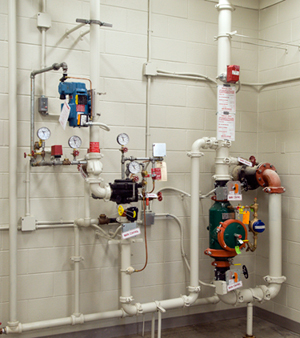"Mechanical, electrical, and plumbing [systems] are very hard to visualize on plans," Thabet explains. "No matter what you do, it's hard to see for the beginner. One of the reasons this building was built this way, without a false ceiling, is to allow students to understand the complexity of the construction of these elements, to realize the coordination that needs to happen when multiple trades need to come in and install [systems].
"One of the things we teach," Thabet continues, "is not how to construct these, but how to coordinate, how to manage, how to work with many teams."
Indeed, the building "has been a huge teaching device," says Sheila Matarazzo, a rising senior from Lovettsville, Va. "We've had multiple assignments that have been [to] look at the first floor, second floor, third floor and explain what's going on."
The building construction program, founded by William Favrao, prepares students for leadership roles in the construction industry. Alumnus Richard Bishop (building construction '67), who founded a successful building company, gave the lead gift for the hall, asking that the building also be named for Favrao, who died in 1977. Many other donors contributed to the building, and private support made up $5.75 million of the building's funding package, compared to $3.55 million from the state. Construction began in November 2006 and was complete by the end of 2007. Students started using the building in the spring 2008.
Among the hundreds of people who gathered at the building for its opening celebration toward the end of that semester were Favrao's daughters, Anne McCracken of Baltimore and Sarah Favrao of Annapolis, Md.
"I just keep saying how astonished he would be," McCracken said of her father. "Thirty-one years ago, it was beyond his wildest imagination that this would happen."
She added that if he were there, her father "would be puffing his pipe and looking up at that name in such wonderment. And he would be so proud--as we are."
Bishop said he wanted Favrao's name on the building because "something about the guy, I always respected him. He was tough, but he was fair. He started that program, and he fought to keep it going over the years."
Cecil Maxson (building construction '52), who also attended the building's opening, recalled, "We were in one room on the third floor of Patton Hall. That was it. Seven people [were] in my class. I've been watching [the program] grow for 56 years. It's amazing."
|
|
|
 |
|
Unlike a traditional academic building, Bishop-Favrao Hall has no drop ceiling. Exposed pipes, their purposes labeled, also run along many of the hall's walls. While the interior might look unfinished to an uninformed observer, that is hardly the case. |
|
|
Bishop-Favrao Hall has four levels. The first floor features a construction lab for experimenting with materials. The second floor has classrooms and a lobby. The third floor offers studio space. The fourth floor contains administrative offices and space for graduate students.
Beliveau says that the first-floor lab will help the university's programs keep pace with technological developments in construction. "Industry is moving really fast now, and with building information modeling, automatic prototyping, and digital imaging, as well as numerical control machines, construction is not going to stay the same," he said. "And so we're investing in much of that equipment as well."
Retired building construction head Vince Cilimberg (building construction '50) taught in the construction program from 1976 to 1995. After the opening ceremony, he called the building "magnificent."
"It's something that I think a lot of building construction graduates would not have imagined that we would have been able to get," Cilimberg noted. "It's something that Yvan [Beliveau] and Richard Bishop have worked so hard for, and now it's come to fruition. It's just outstanding. I'm so happy for the program."
Though Bishop-Favrao Hall opened this year, officials and supporters have been working to bring it about since the late 1990s. Since then, the number of students studying construction has increased faster than expected. Bishop-Favrao Hall was designed with a 300-student program in mind, but the combined enrollment of the building construction department, the Vecellio Construction Engineering Program, and the Myers-Lawson School is already greater than that, Beliveau says.
Jack Davis, dean of the College of Architecture and Urban Studies, says that the university is seeking private support to provide additional space for the construction programs.
 Albert Raboteau is a writer for University Development.
Albert Raboteau is a writer for University Development.



